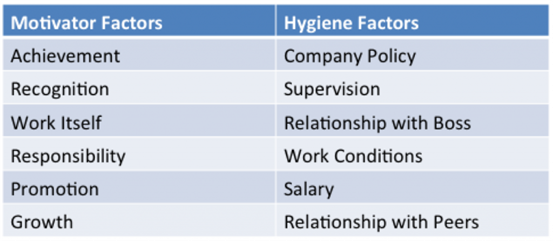Job Satisfaction and Job Dissatisfaction
According to Fredrick Herzberg’s Motivation-Hygiene Theory (also called the Two-Factor Theory), you can love and hate your job at the same time. You can be a doctor who loves healing and solving puzzles, and you can hate doing charts or working with a particular administrator or colleague. Naturally, you’d like to do more of what you love, and less of what you don’t. And, as a leader, you want to enable your coworkers to improve that balance, too.
Back in 1968, Herzberg wrote a piece for the Harvard Business Review called “One More Time: How Do You Motivate Employees?” in which he sought to disentangle factors that led to true job satisfaction from ones that led to dissatisfaction. What Herzberg found was that workers enjoyed achievement, recognition, the work itself, responsibility, promotion, and growth–what he called “motivators.” What workers disliked, in general, was company policy and administration, supervision, work conditions, salary and some relationships (with supervisors, peers, and subordinates)–environmental factors Herzberg called “hygienes.”
Because the sources of job satisfaction were distinct from the sources of dissatisfaction, Herzberg resisted describing them as direct opposites. Instead, he defined the opposite of “satisfaction” as “no satisfaction.” The opposite of “dissatisfaction” he called “no dissatisfaction.” As leaders, it’s important to recognize these distinctions—to learn, in effect, that decreasing employee dissatisfaction and increasing satisfaction are two separate issues.
Herzberg believed that too many managers were confusing moving employees to action (using psychological tactics) with motivation. Motivation, he argued, must come from within. To get people genuinely motivated, you have to appeal to what satisfies them and remove what dissatisfies them, not simply increase the size of the carrots or sticks.
Psychological tactics like bribery may get employees to move for a while, but these tactics don’t usually work for long because these “movers” are not self-generated. As a leader, you want sustained effort and motivated employees. To get that, you need to work on removing environmental dissatisfiers (hygiene) and increasing motivator factors.
Increase Job Satisfaction
If you’re serious about increasing job satisfaction, ask and answer these questions:
Hygiene Factor Questions
- What policies and conditions do employees find most dissatisfying, and why?
- What policy and condition changes might make employees less dissatisfied?
- How must we supervise our staff to keep them from being dissatisfied?
- What work relationships are leading to dissatisfaction, and why?
- How might we improve or alter these work relationships?
- How might we change our compensation structure to reduce dissatisfaction?
Motivator Factor Questions
- What must each employee achieve to feel satisfied?
- How might we better recognize the efforts and achievements of our employees?
- How can we make this employee’s work more interesting?
- How can we create greater responsibility and ownership of work?
- What is a promotion path that allows people to feel satisfied?
- What growth opportunities might elevate satisfaction?





